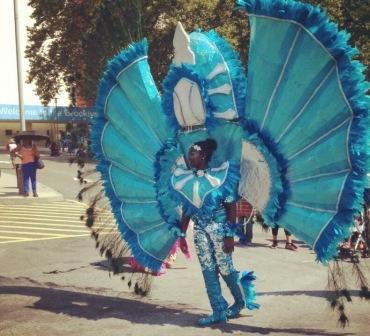West Indian Carnival 2012

Tweet
By Sherrie-Ann de Leon in New York
It was another great weekend for Caribbean culture in New York City as millions of West Indians came from far and wide to play mas’ Brooklyn style.
Organizers say about a half million revellers took to the streets of Flatbush for J’ouvert (early morning Carnival) alone.
Brooklyn J’ouvert is a steelpan-only affair, which many Brooklynites will argue, makes it the best J’ouvert in the world.
Bands competed in the bomb and calypso categories, while J’ouvert masqueraders danced through the dawn in costumes, yes real costumes, that did not include feathered and/or beaded bikinis.
As usual, more than a million spectators made the annual pilgrimage to Eastern Parkway a few hours later for the Carnival parade on Labor Day, in spite of cloudy skies and a slight chill in the air.
They went to see masqueraders shake their beads and ruffle their own colourful feathers down a one mile stretch of the world’s first parkway.
Rain and recession
But both main events took a hit from a combination of low sponsorship, bad publicity, and early Labor Day rain showers.
Yvette Rennie has been organizing Brooklyn’s J’ouvert since 1984.
She said that, while the crowd has decreased slightly over the years, a more troubling trend is emerging among younger revellers.
“The younger generation is not playing mas,” she told Caribbean Intelligence©.
“They are out there. But they’re jumping up in the band but not putting on a costume and getting involved in the culture.
“Somehow we did not teach them the value of playing mas’ (masquerade). Or the true meaning of why we do it.”
Ms Rennie said the diminishing number of revelers paying to play J’ouvert had little to do with the economy.
“People tend to play mas’ more when there is a recession,” she said.
But on the brighter side, she is optimistic that the kids are beginning to understand J’ouvert and they are totally into steelpan music.
Period of uncertainty
Caribbean media consultant Glenda Cadogan said that somehow the vibe of King Carnival did not grab her this year.
“This was the first time in 10 years I did not make it to the Parkway for the Labor Day parade,” she said.
Ms Cadogan said that she went to what is usually her favourite show behind the Brooklyn Museum on Thursday night, but was saddened by the poor attendance and lack of Carnival energy.
She felt that a mid-year change in leadership at the West Indian American Day Carnival Association led to a period of uncertainty which somehow dampened the mood.
Less people
Culture vulture Louie Roberts was at the Museum the next night for WIADCA’s Brassfest event, where he said the crowds were huge but the sound system was thin.
He went to see soca star Machel Montano perform, 48 hours before Montano walked the Parkway as one of the parade’s Grand Marshals.
Mr Roberts also took his own walk along the Parkway and was disappointed with the turnout.
“This is half the number of people I usually see on the Parkway,” he said.
“Less vendors and less people.”
I should mention that these are all Trinbagonians who know more than a thing or two about Carnival.
And they all agreed that a large number of Trinis no longer look forward to going to the Parkway to see mas'.
Talent manager and former Burrokeets Mas’ member Clem Bowen said that, years ago, the Parkway was much more inviting to spectators because there were fewer restrictions.
“Now, mas’ is restricted to one side of the truck,” he said.
“If you pick the wrong side of the street, you are not allowed to move from one area to another, and you might just get stuck watching trucks and non-masqueraders, while the costumes are on the other side of the Parkway.”
Police presence
Another possible reason for this year’s smaller crowds could be last year’s bad publicity after a fatal shooting during J’ouvert and a police shooting four hours after the parade ended.
As expected, police presence was boosted even further at both events this year, restricting movements even more.
But as the giant parade drew to a close, two people were shot near a music truck, one man died after he was stabbed on the Parkway, and a second man died after he was stabbed two blocks away from the parade.
Some commentators object to the Carnival being portrayed in the media as the cause of crime.
“It was great last year to hear Police Commissioner Kelly say Labor Day carnival will continue to be held,” Daily News columnist Jared McCallister wrote.
“Crime, not carnival, is the problem,” he continued.
He pointed out that the 2011 incidents on the parade routes were among dozens of incidents which took place during Labor Day weekend.
"Unfortunately, the carnival, like the rest of New York, is adversely affected by the city-wide violence, but it’s not the cause of crime,“ he wrote.
